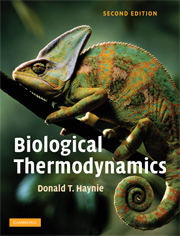Book contents
- Frontmatter
- Contents
- Preface to the second edition
- Chapter 1 Energy transformation
- Chapter 2 The First Law of Thermodynamics
- Chapter 3 The Second Law of Thermodynamics
- Chapter 4 Gibbs free energy – theory
- Chapter 5 Gibbs free energy – applications
- Chapter 6 Statistical thermodynamics
- Chapter 7 Binding equilibria
- Chapter 8 Reaction kinetics
- Chapter 9 The frontier of biological thermodynamics
- Appendices
- Glossary
- Index of names
- Subject index
- References
Chapter 6 - Statistical thermodynamics
Published online by Cambridge University Press: 05 June 2012
- Frontmatter
- Contents
- Preface to the second edition
- Chapter 1 Energy transformation
- Chapter 2 The First Law of Thermodynamics
- Chapter 3 The Second Law of Thermodynamics
- Chapter 4 Gibbs free energy – theory
- Chapter 5 Gibbs free energy – applications
- Chapter 6 Statistical thermodynamics
- Chapter 7 Binding equilibria
- Chapter 8 Reaction kinetics
- Chapter 9 The frontier of biological thermodynamics
- Appendices
- Glossary
- Index of names
- Subject index
- References
Summary
Introduction
Classical thermodynamics provides a phenomenological description of nature, and then only some aspects of nature. The mathematical relationships of thermodynamics are precise, but they do not tell us the molecular origin of the properties of matter. This chapter discusses a means of gaining a molecular interpretation of thermodynamic quantities. If you've spotted the trend we set from page one of this book, you will guess that mathematics will play an important role here. The required mathematical ability is greater than in pages past, but not greatly so. As before, all the main ideas can be expressed relatively clearly in figures or easily in words. And it is important to be able to use the mathematics, even if it is more important to the biochemist to have a good sense of what the mathematics says! We could say that this is what distinguishes the biochemist from the mathematician. It may be that mathematics applies to everything, and it may be that few things are as sublime or beautiful as Leonhard Euler's contributions to number theory, but with apologies to Thomas Alva Edison, it is the physical biochemist who hires the mathematician, not the mathematician who hires the physical biochemist.
The need for working out a theory of thermodynamics grew increasingly evident as the work of British chemist and physicist John Dalton (1766–1844) and Russian chemist Dmitri Ivanovich Mendele'ev (1834–1907) on the atomic theory of matter became more generally accepted after the middle of the nineteenth century.
- Type
- Chapter
- Information
- Biological Thermodynamics , pp. 207 - 249Publisher: Cambridge University PressPrint publication year: 2008



